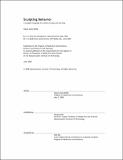Sculpting behavior : a tangible language for hands-on play and learning
Author(s)
Raffle, Hayes Solos, 1974-
DownloadFull printable version (29.67Mb)
Alternative title
Tangible language for hands-on play and learning
Other Contributors
Massachusetts Institute of Technology. Dept. of Architecture. Program in Media Arts and Sciences.
Advisor
Hiroshi Ishii.
Terms of use
Metadata
Show full item recordAbstract
For over a century, educators and constructivist theorists have argued that children learn by actively forming and testing -- constructing -- theories about how the world works. Recent efforts in the design of "tangible user interfaces" (TUIs) for learning have sought to bring together interaction models like direct manipulation and pedagogical frameworks like constructivism to make new, often complex, ideas salient for young children. Tangible interfaces attempt to eliminate the distance between the computational and physical world by making behavior directly manipulable with one's hands. In the past, systems for children to model behavior have been either intuitive-but-simple (e.g. curlybot) or complex-but-abstract, (e.g. LEGO Mindstorms). In order to develop a system that supports a user's transition from intuitive-but-simple constructions to constructions that are complex-but-abstract, I draw upon constructivist educational theories, particularly Bruner's theories of how learning progresses through enactive then iconic and then symbolic representations. This thesis present an example system and set of design guidelines to create a class of tools that helps people transition from simple-but-intuitive exploration to abstract-and-flexible exploration. The Topobo system is designed to facilitate mental transitions between different representations of ideas, and between different tools. A modular approach, with an inherent grammar, helps people make such transitions. With Topobo, children use enactive knowledge, e.g. knowing how to walk, as the intellectual basis to understand a scientific domain, e.g. engineering and robot locomotion. Queens, backpacks, Remix and Robo add various abstractions to the system, and extend the tangible interface. Children use Topobo to transition from hands-on knowledge to theories that can be tested and reformulated, employing a combination of enactive, iconic and symbolic representations of ideas.
Description
Thesis (Ph. D.)--Massachusetts Institute of Technology, School of Architecture and Planning, Program in Media Arts and Sciences, 2008. This electronic version was submitted by the student author. The certified thesis is available in the Institute Archives and Special Collections. Includes bibliographical references (p. 187-192).
Date issued
2008Department
Program in Media Arts and Sciences (Massachusetts Institute of Technology)Publisher
Massachusetts Institute of Technology
Keywords
Architecture. Program in Media Arts and Sciences.